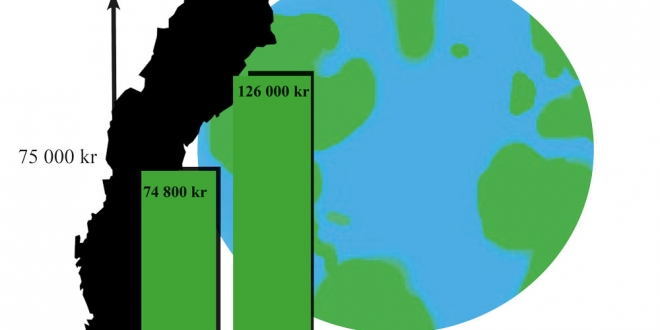Foreign students overpay for their education at Lund University. Jack Senften, vice chairperson of Lund University Student Unions Association, thinks that the fees are problematic and excluding.
Written by: Simon Appelqvist. Translated by: Rebecka McKinnon Forsell
More than 73 million Swedish kronor. That is the amount Lund University received from paying students from outside the EEA (European Economic Area) in 2016. 580 of Lund University’s 41,000 students pay for their education.
Since 2011, students from outside the EEA should pay both admission fee and student fee, which is expensive to many. It varies how expensive it is, but the average cost is 126,000 kronor a year, which is 51,000 kronor higher than what the education cost is estimated to.
The Swedish Higher Education Authority (UKÄ) published the report Kartläggning av studieavgifter (2017) where the issue is explained. In the fees there is an extra increase to cover expenses such as student administration, guidance, economic administration, marketing and recruiting.
Another explanation for the differences is that the paying students often chooses more expensive academic fields.
Strong Criticism
According to Jack Senften, vice chairperson of Lund University Student Unions Association (Lus), the fees are both problematic and excluding.
”The fees make it more difficult to fulfill the task of the Higher Education Act, and to broaden recruiting and participation, when you separate a certain category of students with a background of socioeconomic strain. With the introduction of the student fees there was a drastic decrease in students from Africa for example,” says Jack Senften.
According to Richard Stenelo, International Director at the Division of External Relations at Lund University, the fees are not particularly high.
”I wouldn’t say that it is expensive in comparison to international standards, and the extra costs must be covered by the student fees. We cannot use taxes for that,” says Richard Stenelo.
Lus has aimed strong criticism towards the fact that Lund University accounts for the fees and considers it necessary to create a more rigid foundation of what the fees will cover.
”We want a bigger foundation for what the collected cost and the different increases will contain, especially when it comes to marketing and agents. It requires a discussion about what we think is a reasonable marketing and that it is not a certainty that the students should pay for it,” says Jack Senften.
The Fees are Much Lower at Malmö University
At Malmö University, the average student fee is 46,000 kronor for students outside the EEA.
Martin Gagner, international administrator at Malmö University, thinks that the student fees are a relatively unregulated activity that opens up to local interpretation.
”The transparency in the share of the student fees that are higher than the state-financed amount of compensation are quite poor in general. I hope that there is a more concordant practice between the seats of learning in the future, so that we can have more comparable fee levels,” says Martin Gagner.
EEA and UKÄ
EEA is an abbreviation of the European Economic Area. All of the countries within the European Union as well as Liechtenstein, Iceland and Norway are included.
Citizens who are not from any of these countries and who are not in an exchange program have to pay for their studies in Sweden.
The Swedish Higher Education Authority (UKÄ) is commissioned to inspect the quality of the education, to analyze and follow up on development and to see to the legal rights of the students.
Swedish seats of learning are largely financed by state bills and different academic fields get different amounts of money. The larger the amount of compensation, the higher the student fees become for students outside of the EEA.






